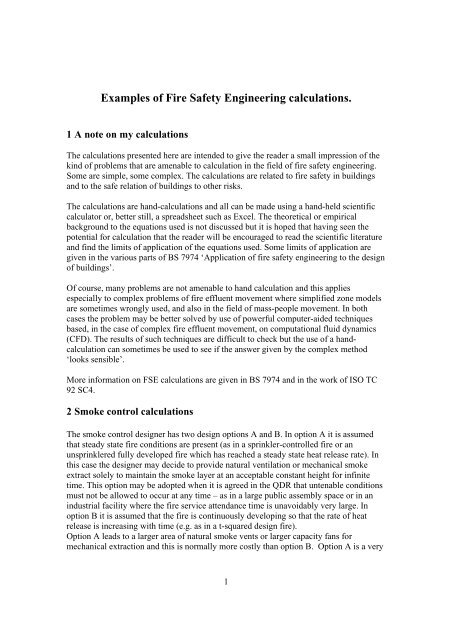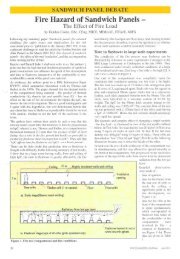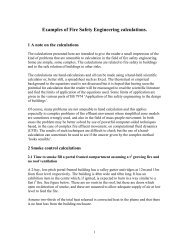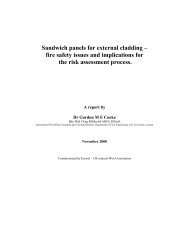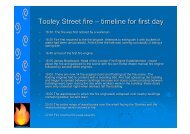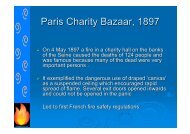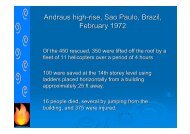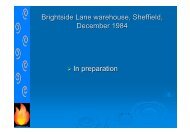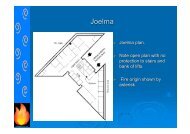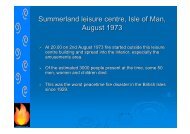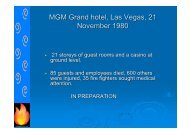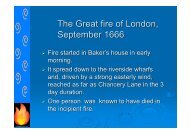Examples of Fire Safety Engineering calculations. - Cooke On Fire
Examples of Fire Safety Engineering calculations. - Cooke On Fire
Examples of Fire Safety Engineering calculations. - Cooke On Fire
You also want an ePaper? Increase the reach of your titles
YUMPU automatically turns print PDFs into web optimized ePapers that Google loves.
<strong>Examples</strong> <strong>of</strong> <strong>Fire</strong> <strong>Safety</strong> <strong>Engineering</strong> <strong>calculations</strong>.1 A note on my <strong>calculations</strong>The <strong>calculations</strong> presented here are intended to give the reader a small impression <strong>of</strong> thekind <strong>of</strong> problems that are amenable to calculation in the field <strong>of</strong> fire safety engineering.Some are simple, some complex. The <strong>calculations</strong> are related to fire safety in buildingsand to the safe relation <strong>of</strong> buildings to other risks.The <strong>calculations</strong> are hand-<strong>calculations</strong> and all can be made using a hand-held scientificcalculator or, better still, a spreadsheet such as Excel. The theoretical or empiricalbackground to the equations used is not discussed but it is hoped that having seen thepotential for calculation that the reader will be encouraged to read the scientific literatureand find the limits <strong>of</strong> application <strong>of</strong> the equations used. Some limits <strong>of</strong> application aregiven in the various parts <strong>of</strong> BS 7974 ‘Application <strong>of</strong> fire safety engineering to the design<strong>of</strong> buildings’.Of course, many problems are not amenable to hand calculation and this appliesespecially to complex problems <strong>of</strong> fire effluent movement where simplified zone modelsare sometimes wrongly used, and also in the field <strong>of</strong> mass-people movement. In bothcases the problem may be better solved by use <strong>of</strong> powerful computer-aided techniquesbased, in the case <strong>of</strong> complex fire effluent movement, on computational fluid dynamics(CFD). The results <strong>of</strong> such techniques are difficult to check but the use <strong>of</strong> a handcalculationcan sometimes be used to see if the answer given by the complex method‘looks sensible’.More information on FSE <strong>calculations</strong> are given in BS 7974 and in the work <strong>of</strong> ISO TC92 SC4.2 Smoke control <strong>calculations</strong>The smoke control designer has two design options A and B. In option A it is assumedthat steady state fire conditions are present (as in a sprinkler-controlled fire or anunsprinklered fully developed fire which has reached a steady state heat release rate). Inthis case the designer may decide to provide natural ventilation or mechanical smokeextract solely to maintain the smoke layer at an acceptable constant height for infinitetime. This option may be adopted when it is agreed in the QDR that untenable conditionsmust not be allowed to occur at any time – as in a large public assembly space or in anindustrial facility where the fire service attendance time is unavoidably very large. Inoption B it is assumed that the fire is continuously developing so that the rate <strong>of</strong> heatrelease is increasing with time (e.g. as in a t-squared design fire).Option A leads to a larger area <strong>of</strong> natural smoke vents or larger capacity fans formechanical extraction and this is normally more costly than option B. Option A is a very1
conservative option as it ignores the smoke produced in the smouldering anddevelopment phase and the associated time taken to get to full development. Most presentday design is based on Option B.A typical plot <strong>of</strong> thickness and temperature <strong>of</strong> smoke layer with time (or any otherderivative eg optical density, toxicity etc), is shown below:2.1 Time to smoke fill a portal framed compartment assuming a t 2 growing fire andno ro<strong>of</strong> ventilationA 2-bay, low-pitch portal framed building has a valley gutter and ridges at 12m and 13mfrom floor level respectively. The building is 40m wide and 60m long. It has anexhibition item in the centre which, if ignited, is expected to burn in a way similar to afast t 2 fire. See figure below. There are no vents in the ro<strong>of</strong>, but there are doors whichopen on detection <strong>of</strong> smoke, and these are assumed to allow adequate supply <strong>of</strong> air at lowlevel to feed the fire.Assume two-thirds <strong>of</strong> the total heat released is convected heat in the plume and that thereis no heat loss from the building enclosure.Determine the rate at which the compartment will fill with smoke, and find the time forthe smoke to fill down to within 5m and 2m <strong>of</strong> floor level. Determine if occupants aresafe if they leave the building within 3 minutes <strong>of</strong> ignition2
Figure. Cross section through portal framed buildingData given:average height <strong>of</strong> enclosure = 12.5m i.e. (12+13)/2length <strong>of</strong> building = 60mwidth <strong>of</strong> building = 40mambient air temperature, T0= 15 o Cdensity <strong>of</strong> air, ρ = 1.2kg/m 3specific heat <strong>of</strong> air C p = 1.92clear air layer needed = 6mfire growth parameter for fast t 2 fire a = 0.0444 kW/s 2height <strong>of</strong> virtual source above base <strong>of</strong> fire, z = 0From the literature (e.g. CIBSE Technical Memorandum TM19: 1995):o2⎪⎧t ⎪⎫Q = 1000⎨⎬( CIBSE Eqn 4.1) (1)⎪⎩ t g ⎪⎭where tg= characteristic growth time. For a fast fire tg= 150 and Equation (1) becomesQ = 0.0444t2M1/ 35 / 3= 0.071Qp( z − zo)(CIBSE Eqn 5.6) (2)Q= T(CIBSE Eqn 5.17) (3)pTm+MCpvMTρ Tooom= (CIBSE Eqn 5.19) (4)A spreadsheet is prepared which calculates smoke layer temperature and thickness as afunction <strong>of</strong> time.3
First we assume the worst condition, that the plume height z remains constant as timeprogresses (in reality the plume height reduces as the thickness <strong>of</strong> smoke layer increasesand thus the height over which air entrainment takes place reduces with time).Substituting data gives:time for smoke layer to reach down to 5m from floor level = 325sectime for smoke layer to reach down to 2m from floor level = 488secAssume now that the air entrainment reduces as the smoke layer increases in thicknessi.e. z reduces. We now have:time for smoke layer to reach down to 5m from floor level = 534sec time for smoke layerto reach down to 2m from floor level = 700secSo we see the large increase in smoke fill time, i.e. from 488 to 700 seconds for smoke toreach to within 2m <strong>of</strong> floor level. Thus using constant z is conservative – if occupantscould evacuate within this period they would be safe.We are asked if the occupants are safe to complete their evacuation by 3 minutes fromignition. From the calculation the smoke layer is approximately 2m deep (well abovehead height) and at a temperature <strong>of</strong> 34 o C for constant z and at 38 o C for reducing z, atthis time. The conditions are clearly tenable.2.2 Time to smoke fill an enclosure with sloping ceiling etcOften, in a multi-zone model used for calculating the rate <strong>of</strong> smoke fill in an enclosure,the enclosure will have a flat ro<strong>of</strong> or ceiling and this is the simplest geometry to modelbecause the plan shape taken by the lower surface <strong>of</strong> the smoke layer does not change asthe smoke fills the enclosure from top downwards.Figure 1A shows a simple rectangular enclosure with an axi-symmetric fire plumelocated at the centre <strong>of</strong> the floor. Figure 1B shows an enclosure <strong>of</strong> the same height butwith a 45degree sloping ro<strong>of</strong> (some modern atria are <strong>of</strong> this shape). Assuming that eachenclosure has the same width and the same length and fires with the same rate <strong>of</strong> heatrelease, the only variable is the shape <strong>of</strong> the ro<strong>of</strong>. The enclosure with the inclined ro<strong>of</strong>will fill more rapidly, and there will be less escape time for occupants, especially if theyare located above the floor <strong>of</strong> the enclosure eg on a balcony. (Figures 1A and 1B havebeen shown with roughly the same amount <strong>of</strong> smoke in the layer). In the enclosure shownin Figure 1B the height <strong>of</strong> the vertical plume is much smaller and therefore the amount <strong>of</strong>air entrained is far less and the smoke entering the layer will be hotter than in Figure 1A4
At an early stage in the fire development in the enclosure with a sloping ro<strong>of</strong>, Figure 1C,there may be the temporary formation <strong>of</strong> a sloping plume/jet. If the angle <strong>of</strong> slope islarge there may be a small amount <strong>of</strong> air entrained into the sloping plume and it is amatter <strong>of</strong> engineering judgement if this can be ignored. Note that when the slope is zerothe amount <strong>of</strong> air entrained in the layer spreading below the ceiling is assumed to be zero– this is an explicit assumption in the ceiling jet equation. If the ro<strong>of</strong> is steeply inclined,the height over which air is entrained is different on the ‘opposite surfaces’ <strong>of</strong> the plumeso that an average height should be adopted in the plume equation. Again, the greater theplume height the greater the entrainment.In the non-flat ro<strong>of</strong> condition the location <strong>of</strong> the fire needs to be considered. In Figure 1Dit is important to consider this fact and assume the worst fire location (fire at position 2)if a sensitivity analysis is not made: if the fire is near the tall wall more air will beentrained in the vertical axi-symmetric plume and the layer depth will initially increasemore rapidly than in the same fire located near the short wall. Note that if the plumecontacts the wall before reaching the smoke layer the axi-symmetric plume equation can5
only be used if the entrainment factor is reduced; it is reduced by 50% if the fire islocated directly against the wall thus assuming that air is entrained from only one side <strong>of</strong>the plume through its full height.When making the smoke fill calculation it is normally necessary to represent the ro<strong>of</strong>shape as a series <strong>of</strong> rectangular shapes. Figure 1E represents part <strong>of</strong> a sloping ro<strong>of</strong> at thetop, in which each rectangle has the same area as the actual smoke filled shape at thatlevel (ie w1.h1 represents the area <strong>of</strong> shaded triangle 1). In this way it is possible tointegrate the volume <strong>of</strong> smoke produced incrementally. A curved ro<strong>of</strong> would berepresented as a number <strong>of</strong> rectangles, Figure 1F.In the process <strong>of</strong> idealizing the sloping or curved volume as a series <strong>of</strong> rectangularvolumes the engineer should keep in mind the physics <strong>of</strong> smoke and air entrainment andalso the effects <strong>of</strong> heat losses from the enclosure surfaces. The following are someaspects which should be considered and their effect may need to be quantified insensitivity analyses:a) For a given heat release rate from the fire, the greater the heat loss from the enclosure(e.g. due to low thermal insulation <strong>of</strong> the walls and ceiling), the lower the temperature <strong>of</strong>the smoke layer, and the greater the smoke layer thickness.b) For the sloping ro<strong>of</strong>, the axi-symmetric plume height is reducing more rapidly andtherefore less air is entrained and the smoke layer temperature is higher than in the case<strong>of</strong> the enclosure with a flat ro<strong>of</strong>. The higher the smoke layer temperature, the moreradiation produced by it.c) the higher the plume the greater the amount <strong>of</strong> air entrainedThe engineer must consider the effect <strong>of</strong> any partial barriers to the flow <strong>of</strong> smoke. InFigure 1G a balcony is present at B. The smoke fill time for a fire on the floor away fromthe balcony, Figure 1H, will be greater than if the fire is assumed to occur under thebalcony, and this is because the spill plume formed by the balcony has a largerentrainment factor than the axi-symmetric plume (compare the levels in Figures 1G and1H). Obstructions to horizontal smoke flow, e.g. the downstand beam located at C inFigure 1J, also needs to be considered as such obstructions will increase the entrainmentand lead to a lower temperature in the smoke layer remote from the fire, perhaps leadingto stratification and loss <strong>of</strong> buoyancy at large distances.The following <strong>calculations</strong> on sloping ro<strong>of</strong>s were made as part <strong>of</strong> work <strong>of</strong>ISO TC 92 SC4 and was originally presented in a PowerPoint presentationdated October 2009.Building is 80m long and has cross section as shown below (40m high by 40m wide). Ithas a sloping ro<strong>of</strong>. Design fire is steady state 5MW from time zero.In one analysis the ro<strong>of</strong> portion is idealised as 4 rectangles as shown here. In otheranalyses it is idealised as one rectangle <strong>of</strong> equivalent area.6
Two conditions considered – central plume and <strong>of</strong>fset plume – as belowNow, see below, the ro<strong>of</strong> is idealised as a single rectangle (40m by 10m) <strong>of</strong> equivalentarea7
Offset plume is 10m from wall.Average plume height is 22.5m before smoke builds down to this level.Entrainment into sloping plume is ignored. Smoke fills rectangular spaces - early stageshown left, later stage shown right belowThe axi-symmetric plume equation is used as below1/ 3pM = 0.071Qz5/ 3Model assumptions are as follows:• The virtual source term, z0, is assumed to be zero, which is <strong>of</strong>ten an assumption inpractical design.• Plume/wall interaction is ignored• Heat losses to the enclosing surfaces are ignored.• Effects such as stratification are also ignored.• For the <strong>of</strong>fset plume the entrainment in sloping plume early on is zero. Thisentrainment could be accounted for.8
The <strong>calculations</strong> have been carried out using an Excel spreadsheet written for thepurpose. This uses a volume integration method and has been made using time steps <strong>of</strong> 1second. Smoke layer depth is plotted against time.Convective heat release rate is assumed to be 2/3 <strong>of</strong> the 5MW total heat release rate.Calculation procedure• Decide time step e.g. 1 second in these <strong>calculations</strong>• For each time step do the following:• State total heat release rate, Qt (kW)• Calculate convective heat release rate, Qp (kW)• Calculate rate <strong>of</strong> smoke mass, M (kg/sec)• Calculate absolute temperature <strong>of</strong> smoke, Tm (K)• Calculate increment in smoke volume, deltaV, (m3)• Calculate total volume <strong>of</strong> smoke by integrating the smoke volume increments, V(m3)• Calculate smoke layer thickness, (m) and, if needed, clear layer heightManual intervention in the spreadsheet is necessary where:1. the plume height changes from a constant to a variable (as in the <strong>of</strong>fset plume<strong>calculations</strong>)2. where the plan area <strong>of</strong> the smoke reservoir changes (e.g. when the smoke enters anew rectangle)9
Results are plotted as shown above and the following conclusions can be drawn:• There appears to be little effect on smoke layer depth <strong>of</strong> a) rectangle shape used torepresent the sloping ro<strong>of</strong> or b) position <strong>of</strong> plume.• The lowermost curve is for smoke layer thickness for a ro<strong>of</strong> which is 30m high. Theother curves are for a 40m ro<strong>of</strong> height (to the top <strong>of</strong> ro<strong>of</strong>).• Plotting clear air layer thickness (i.e. 40m minus smoke layer thickness) gives a moremeaningful comparison as shown in next graphThis following graphs show the clear layer height comparison. There is only a smalldifference in smoke fill rate for both the rectangle assumptions (compare shaded areas).Effect <strong>of</strong> time step is shown below from which it appears to have little effectWe now look at a triangular smoke fill space10
• This assumes the ro<strong>of</strong> in the previous examples is the building.• Smoke fill rates for central plume and <strong>of</strong>fset plumes are presented in next figure• Again the entrainment in the sloping plume is ignoredResults are plotted belowConclusions (for building geometry and plume positions adopted) are:1. it appears that the idealised shapes assumed for the ro<strong>of</strong> has little effect on smoke filltime if the clear layer height is <strong>of</strong> principal interest. This applies, surprisingly, forcentral plume and <strong>of</strong>fset plume conditions for the whole building. When the ro<strong>of</strong>alone is the building the position <strong>of</strong> plume does affect fill, as one would expect fromintuition.2. in the integration <strong>of</strong> volume it appears that time step is not significant (for 1sec and10sec)3 Thermal deflections/stresses.3.1 The thermal bowing deflection at mid-height <strong>of</strong> a steel stud fire wallA firewall comprises a fire protecting layer <strong>of</strong> plasterboard either side <strong>of</strong> an assembly <strong>of</strong>steel studs. The vertical studs are <strong>of</strong> a light steel channel section 200mm deep betweenflanges and the studs are 6m high and simply supported at their ends. In an indicative fireresistance test on a 1m high specimen <strong>of</strong> the whole construction exposed to the ISO 834fire on one face it was found that the thermocouple temperatures <strong>of</strong> the ‘hot’ and ‘cold’11
flanges <strong>of</strong> the steel channel were 700 and 300 o C respectively. The two conditionsconsidered are shown in the figure below.Assuming a) the plasterboard does not affect the bowing behaviour, and b) the steelproperties are unaffected, what is the mid-height deflection ( Δmid −height) <strong>of</strong> the 6m highwall in the horizontal direction assuming the same fire exposure?We see that we can assume the ends <strong>of</strong> the studs are free to rotate and that thetemperature difference across the stud channel section is the same as in the testFrom the literature (<strong>Cooke</strong> G M E, Stability <strong>of</strong> lightweight structural sandwich panelsexposed to fire, Structures in <strong>Fire</strong> (SiF 02) Conference Proc., University <strong>of</strong> Canterbury,Christchurch, New Zealand, March 2002, or <strong>Cooke</strong> G M E, When are sandwich panelssafe in fire ?- Part 2 Avoiding collapse, <strong>Fire</strong> Engineers Journal, UK, Sept 1998, pp 25 –33):Figure. The bowing <strong>of</strong> a 6m high steel stud wall2α H ( T1− T2 )Δmid − height=8 dWhereα = coefficient <strong>of</strong> linear expansion (14x10 -6 / o C for steel at elevated temperature)H = height <strong>of</strong> member (m)T1= temperature <strong>of</strong> ‘hot’ face ( o C)T2= temperature <strong>of</strong> ‘cold’ face ( o C)d = distance between faces (m)12
Substituting values in the equation gives:Δ− 6 214 × 10 × 6 × (700 − 300)mid −height== 0.126m8 × 0.203.2 The thermal bowing deflection at the top <strong>of</strong> a steel stud firewallUsing the same data as for the problem above, calculate the horizontal deflection at thetop <strong>of</strong> the wall ( Δtop) assuming it is a cantilever (i.e. it is direction-fixed (encastre) at thebase and free at the top to move both laterally and vertically)From the literature (as above example)2α H ( T T ) 1−2Δtop=2 dComparing the denominator in this equation with the denominator in the equation in theabove example we see that the defection at the top is four times the deflection <strong>of</strong> thesimply supported member at mid-height, so:Δ top= 4 x 0.126 = 0.504m3.3 The thermal bowing deflection at the top <strong>of</strong> a tall steel stud firewall in asimulated fire resistance testIn a fire resistance test the measured horizontal deflection <strong>of</strong> a 3m high partition at midheightwas 200mm. What would be the corresponding deflection for a partition <strong>of</strong> thesame construction 6m high, assuming the same fire exposure conditions and onlygeometrical thermal bowing effects?13
Figure. Bowing deflection for double height wall.From the governing equation (as above example):2α H ( T1− T2 )Δmid −height=, it is clear that deflection varies as the square <strong>of</strong> the height.2 dTherefore:⎧26 ⎫Δmid − height= 200 ⎨2⎬ = 800mm⎩ 3 ⎭3.4 The lateral bowing <strong>of</strong> a heated slender steel memberA very slender vertical steel rod 2m long is position-fixed at both ends, i.e. the rod is pinendedand the ends cannot move axially. It is then heated uniformly along the wholelength through a temperature <strong>of</strong> 400 o C. Determine the lateral bowing deflection at midlengthassuming a) the rod bows into a circular arc and b) the rod does not shorten due tocompression caused by axial restraint at the ends.14
20degCL=2mD420degCFigure. Effect <strong>of</strong> suppressing axial expansion <strong>of</strong> slender elementFrom the literature (<strong>Cooke</strong> G M E, Stability <strong>of</strong> lightweight structural sandwich panelsexposed to fire, <strong>Fire</strong> and Materials, 2004: 28: pp299-308 (for full details go to MyPublications, Sandwich panels)D = L( 0.375αT)1/ 2−61/ 2D = 2 (0.375×14×10 × 400) = 0.0916m3.5 The hypothetical expansion-restraint force for a squat steel sectionA solid steel section is 150mm square and 0.5m long. It is longitudinally restrained at itsends so that it is unable to expand longitudinally. It is heated from room temperature (say20 o C) to 700 o C, see figure below. What expansion force is developed, assuming elasticbehaviour and that buckling does not occur?stressElastic Modulus E = = strainP /Δ /AL(1)Where P = axial force (N)A = Cross-section area (mm 2 )Δ = unrestrained expansion (mm)L = length <strong>of</strong> member (mm)15
The unrestrained expansion is given by:Figure. Restrained axial expansion <strong>of</strong> steel sectionΔ = α L( T ) 1− T2 (2)Where α = coefficient <strong>of</strong> linear thermal expansion (14x10 -6 /oC for steel)T1= temperature when hot ( o C)T = temperature when cold ( o C)2Substituting (2) in (1) and rearranging gives:P = α AE( T ) 1− T2 (3)Assume E 700 = 0.3 <strong>of</strong> the room temperature value and assume room temperature value is200kN/mm 2From Equation (3)P = 14 x 10 -6 x 150 2 x 0.3 x 200,000 x 680 = 12,852kN. Note that this is a massive forceand in practice the end restraints would probably move apart and elastic and plasticdeformation in the steel section would occur.4 <strong>Fire</strong> Fighting <strong>calculations</strong>4.1 The pressure at the highest outlet <strong>of</strong> a wet riser16
A wet riser is provided in an 8-storey building with an outlet at every storey. Thehighest outlet is 26m above the fire fighting pump, see Figure below. Assuming theavailable pressure from a fire fighting pump is 8 bar, what is the water pressure at thehighest riser outlet assuming it is in use and is required to provide a flow <strong>of</strong> 22 l/s? Ignorelosses in the hose connecting the pump to the riser inlet.Figure. Wet riser and pump diagramData: the developed length <strong>of</strong> the steel pipe work from pump outlet to the highest outletfrom the wet riser is 65m and the pipe is 100 mm internal diameter. The loss <strong>of</strong> head dueto friction is assumed to be 0.1m/m at a flow <strong>of</strong> 22 l/s. Note that I bar pressure(100,000N/m 2 or 14.5 pounds/square inch) corresponds approximately to 10m head <strong>of</strong>water.Available static head at highest outlet (i.e. no flow) = 8 – 26/10 = 5.4 barFriction loss in pipe = length <strong>of</strong> pipe x friction loss per metre = 65 x 0.1 = 6.5m whichcorresponds to 0.65 barTherefore available pressure at highest outlet with flow <strong>of</strong> 22 l/s = 5.4 – 0.65 = 4.75 bar4.2 The pressure needed at a pump appliance to get a good jet <strong>of</strong> water.A fireman’s jet with a nozzle <strong>of</strong> 20mm internal diameter is being used on the 6 th floor <strong>of</strong>a building in which there is no fire main. Five lengths <strong>of</strong> 70mm diameter hose each 25mlong are connected and run from the pump appliance up the staircase to the fire floor (the5 th floor which is 15m above the pump appliance). The pressure required at the nozzle toget a good jet <strong>of</strong> water is assumed to be 4 bar. What pressure is required at the pumpappliance outlet?17
To raise the water through 15m requires a pressure <strong>of</strong> 1.5 bar. The pressure loss in 5lengths <strong>of</strong> hose assuming a loss <strong>of</strong> 0.2 bar/length = 1.0 bar. Therefore pressure needed atpump = 4.0 + 1.5 + 1.0 = 6.5 bar.4.3 The effect <strong>of</strong> changing the hose nozzle diameter on the range <strong>of</strong> a fire fighting jetA fireman’s hose with a nozzle outlet <strong>of</strong> 20mm internal diameter has a range, say, <strong>of</strong> 25mfor a pressure <strong>of</strong> 3.5bar at the nozzle (range is the horizontal distance to which most <strong>of</strong>the water is thrown when the nozzle is at the optimum angle, usually around 35 o to thehorizontal). If the nozzle is changed for one with a 25mm internal diameter nozzle, whatwill be the range assuming the same pressure at the nozzle?Figure. <strong>Fire</strong>man’s hose water rangeFrom the literature (BRE IP 16/84) the relationship between range R, pressure p, anddiameter d, is given by:R =0.42 0.465.47p dHence we can say that0. 46R ⎧1d ⎫is proportional to1⎨ ⎬ so thatR2⎩d2⎭R = R12⎧ d⎨⎩d12⎫⎬⎭0.46Substituting values gives:0.46⎧20⎫R1= 25⎨⎬ = 22.5m⎩25⎭4.4 Sucking water up from a low level reservoir for fire fightingA pump appliance has access to water in a reservoir which is suitable for fire fightingpurposes. The level <strong>of</strong> the water is 11m below the pump appliance and sufficient length<strong>of</strong> hard hose is available to reach it. What suction pressure is needed to lift the water upto the appliance?18
The question is meaningless since it is impossible in practice to lift water up through apipe by more than 8m without getting cavitation.5 Thermal radiation5.1 Simplification <strong>of</strong> configuration factors for thermal radiation <strong>calculations</strong>Introduction.It is sometimes necessary in fire safety engineering projects to make <strong>calculations</strong> <strong>of</strong>radiation intensity. This may be necessary, for example, when buildings are close to eachother and there is a possibility that fire can spread by radiation from one building to theother. Or, within a building, there may be fuel packages near each other which need to beseparated, but by how much?The calculation requires the use <strong>of</strong> radiation configuration factor as will be shown below.The configuration factor can be numerically tedious to calculate and it is advantageous touse simple equations where possible. The following note determines the errors inconfiguration factors which have been simplified. The stimulus for this work came fromengaging in the work <strong>of</strong> ISO committee SC4 <strong>of</strong> TC 92 ‘<strong>Fire</strong> <strong>Safety</strong> <strong>Engineering</strong>’ and thenote is the author’s contribution to the work in mid-2008.I asked myself the question ‘Might it be possible to use an equation for the configurationfactor which is less complex than that relating to a cylinder (the cylinder represents anidealization <strong>of</strong> a flame in this case) while retaining reasonable accuracy?’ For examplecould the equation for a rectangle or, simpler still, the equation for an ellipse be used?This note indicates that this is feasible.Objective and assumptions.This paper examines the numerical error in the value <strong>of</strong> a radiation configuration factor ifit is assumed that a cylinder can be considered as a rectangle or an ellipse <strong>of</strong> the sameoverall geometric size and same separation distance between radiator and receiver(target). In all cases:• the receiver is parallel to the radiator• the receiver is opposite the centreline <strong>of</strong> the radiator at the bottom• the radiator is isothermal.BackgroundThe radiation intensity (I 1 ) emitted from a hot body is related to the absolute temperature(T) <strong>of</strong> the radiator by the following equation:I 1 = εσT 4 (1)where:19
ε = emissivity <strong>of</strong> the surface <strong>of</strong> the radiator (value from 0 to 1)σ = Stefan-Boltzmann constant (5.67×10 -8 W m -2 K -4 )The intensity <strong>of</strong> radiation received (I 2 ) at a point some distance from the radiator isgeometrically related to the emitted radiation intensity by a radiation configuration factor,sometimes called the view factor, (φ) such that:I 2 = φI 1 (2)The smaller the value <strong>of</strong> φ the smaller the intensity <strong>of</strong> radiation received. φ has a valuebetween 0 and 1 and can be visualized as the solid angle seen when looking at theradiator from the receiver (target).Configuration factors given in text books display varying amounts <strong>of</strong> complexity andsometimes include errors in their reproduction over the years. The practicing fireengineer would prefer to use a simple and reliable equation where there is a choice. Aswill be seen below, the configuration factor for a cylindrical shape is relatively complexand it is easy to introduce errors when substituting numerical values. Some simplificationand small inaccuracy is considered acceptable when considering the other simplifyingassumptions used in fire engineering – assumptions, for example, on size, shape andorientation <strong>of</strong> flame, flame emissivity and temperature.Nature <strong>of</strong> comparative analysisIn the following analysis the radiation is assumed to be produced by a pool fire <strong>of</strong>cylindrical form <strong>of</strong> radius r. The receiver (target) ‘sees’ only a portion <strong>of</strong> the cylindricalfire (portion represented by line D when seen from point S in Figure 1). If, for simplicityin calculating the configuration factor, the fire is assumed to be represented by a flatrectangular surface, the question then arises ‘Where should the flat radiator be positionedrelative to the receiver to get roughly the same value <strong>of</strong> configuration factor as for thecylinder?’Figure 1 shows a plan view <strong>of</strong> the cylinder and 3 positions <strong>of</strong> a flat radiator <strong>of</strong> width 2r atpositions A, B and C. It is noted that when the receiver is close to the radiator, ie at pointS, only a portion <strong>of</strong> the surface <strong>of</strong> the cylinder is ‘seen’ by the receiver i.e. a width lessthan 2r and this is indicated by arc line D in Figure 1; note also that the separationdistance varies along the arc. The separation distances for the three positions <strong>of</strong> the20
ectangular flat radiator are shown in the figure in relation to a close receiver at S.Figure 1. Plan view showing the radiator conditions considered (rectangles atstations A, B, C and cylinder at arc line D)It is clear that a flat radiator at C will lead to an over estimate <strong>of</strong> configuration factor andat A will lead to an under estimate when compared to the cylindrical surface. Byinspection <strong>of</strong> Figure 1, for a close receiver it seems position B would be a good choice. Itshould be noted that Figure 1 shows the receiver at S, close to the radiator, and this willlead to differences between the four conditions; with large separation distances (with thereceiver at point T) the differences will be less noticeable.It has also been suggested (Tanaka) that the cylindrical radiator and the rectangularradiator can both be considered as an ellipse having the same major and minor axisdimensions as the rectangle, and this has the advantage that the equation for theconfiguration factor is further simplified. The effect <strong>of</strong> using the ellipse has also beenexamined in the comparisons below.The cylinder as radiatorThe equation for the configuration factor φ for a cylinder is given by Hamilton andMorgan [1] by:φ = tanπ D⎛⎜⎝L ⎞ L ⎡ A − 2D⎟+ ⎢ tan2D −1⎠ π ⎣ D AB1 −1−1−1A(D −1)1− tanB(D + 1) DD −1⎤⎥D + 1⎦(3)WheredD =rlr2 22 2L = = ( + ) = ( − )A D 1 + LB D 1 + LFor the practising fire safety engineer who wishes to make a one-<strong>of</strong>f calculation thecalculation using Equation (3) is prone to error even if the correct equation is used. Alsothe equation found in the literature may be incorrect due to typographical errors.21
Figure 2 Configuration parameters for a cylindrical radiator with a parallel receiverFor example, the equation given in Howell’s catalogue [2] is different to the equationcited by Hamilton and Morgan though similar in form. The Hamilton and Morganequation has been adopted in the present paper as it stems from an authoritative andimportant reference and was tabulated for a range <strong>of</strong> values <strong>of</strong> D and L.Furthermore the Hamilton and Morgan equation is adopted in the SFPE Handbook <strong>of</strong><strong>Fire</strong> protection <strong>Engineering</strong>, 3 rd edition though, strangely, with different nomenclature (Inthe SFPE handbook, L is said to equal L/R which is an impossibility, and there is no Land R indicated in the accompanying SFPE diagram). [Inform editor <strong>of</strong> SFPE handbook]The rectangle as radiatorFor the area bounded by ABCD, Figure 3, the equation for the configuration factor φ isgiven [2] by:1 ⎪⎧x⎪⎫−1z z−1xφ = ⎨ tan + tan ⎬ (4)2π2 22 2 2 22 2⎪⎩ x + y x + y z + y z + y ⎪⎭22
EBCHzRectangularradiatorJFGD90 oxyAParallelx, y and z are measured recieverfrom intersection at DFigure 3 Configuration parameters for a rectangular radiator with a parallel receiver.By inspection it is clear that this is a relatively simple equation to solve as there are onlythree parameters to consider and these may be easily entered into a spread sheet.Since configuration factors are additive and subtractive we can see from Figure 3 that theconfiguration factor for area bounded by ABEF is twice that for area ABCDThe ellipse as radiator.Tanaka has suggested [4] that for many practical fire engineering <strong>calculations</strong> theconfiguration factor for an ellipse can be used in place <strong>of</strong> the configuration factor for arectangle. The original source <strong>of</strong> the configuration factor equation for the ellipse is notknown and the equation given below is therefore that given in Tanaka’s paper. For thewhole area <strong>of</strong> the ellipse shown in Figure 4, in which the radiator and target are parallel,as in all the comparisons, the equation for the configuration factor φ is given byEquation (5):φ =ab(5)2 2 2 2( s + a )( s + b )23
Figure 4 Configuration parameters for an elliptical radiator with a parallel receiver at A or B.It should be noted that Equation (5) assumes the target is at A opposite the centre <strong>of</strong> theellipse, not at the base B, as in the other comparisons made. To correct for this, the value<strong>of</strong>φ has been halved.Comparison <strong>of</strong> configuration factor for rectangular and cylindrical radiators(rectangle coincident with diameter).To facilitate the direct comparison <strong>of</strong> configuration factor for cylinder and rectangle, thewidth <strong>of</strong> the rectangle, 2x, should equal the diameter <strong>of</strong> the cylinder, 2r, and the height <strong>of</strong>the rectangle, z, should equal d, using the nomenclature in Figures 2 and 3.The comparisons have been made for r = x = 1 and z = l = 4. Therefore the rectangle is 2units wide by 4 units high and the cylinder is also 2 units diameter and 4 units high.In this case the rectangle is positioned at the cylinder diameter i.e. at station A inFigure 1, and the comparison, Figure 5, shows that the configuration factor for thecylinder is greater than that for the rectangle at small separation distances. This isintuitively as expected because the front face (nose) <strong>of</strong> the cylinder is closer to thereceiver than the face <strong>of</strong> the rectangle (in the latter all the radiating surface is in the sameplane and coincident with the diameter <strong>of</strong> the cylinder). Hence the use <strong>of</strong> theconfiguration factor for a rectangular radiator coincident with the diameter would not beconservative i.e. it would be unsafe.24
0.5rectangle0.450.4cylinder0.350.30.250.20.150.10.0500 2 4 6 8 10Separation distanceFigure 5 Comparison for cylinder and rectangle (rectangle coincident with diameter)Configuration factorComparison <strong>of</strong> configuration factor for rectangular and cylindrical radiators(rectangle nearer to target by radius/2)Again, from Figure 1, it seems intuitive that placing the rectangle at station B, i.e. at r/2,would provide a better equivalent position <strong>of</strong> the rectangular radiator. The comparison isshown in Figure 6 and indicates very good agreement.0.5cylinder0.45rectangle at r/20.40.350.30.250.20.150.10.0500 2 4 6 8 10Separation distanceFigure 6 Comparison for cylinder and rectangle (rectangle nearer by r/2)Configuration factorComparison <strong>of</strong> configuration factor for elliptical, rectangular and cylindrical radiators(rectangle and ellipse at station A, Figure 1)Here again the ellipse and rectangle have the same overall size as the cylinder. Theellipse and rectangle are located at station A, Figure 1, i.e. on the diameter. Thecomparison, in Figure 7, shows reasonably good agreement, but the ellipse, like therectangle, slightly underestimates the value <strong>of</strong> configuration factor, but this may beacceptable bearing in mind the other uncertainties in radiation <strong>calculations</strong>.25
Configuration factor0.250.20.150.10.050ellipserectanglecylinder0 2 4 6 8 10Separation distanceConclusions.Figure 7 Comparison for cylinder, rectangle and ellipse (rectangle and ellipseposition coincident with cylinder diameter)<strong>Fire</strong> engineers have to make many simplifications in their work. For example, in radiation<strong>calculations</strong> it is helpful to be able to use a simple equation for a configuration factor toreduce the possibility <strong>of</strong> numerical error, especially important in one-<strong>of</strong>f fire safetyengineering <strong>calculations</strong>. It is clear that the equation for the configuration factor <strong>of</strong> anellipse is simple whereas that for a cylinder is relatively complexIt has been shown, Figure 6, that a cylindrical radiator (representing, for example, acircular pool fire), can be considered to be a rectangular radiator in the calculation <strong>of</strong>radiation configuration factor with little error if the separation distance is taken as thedistance from the cylinder centerline to the receiver minus half the radius <strong>of</strong> the cylinder.It also appears, Figure 7, that a cylindrical or rectangular radiator can be considered to bean elliptical radiator and this further simplifies the calculation (compare the complexity<strong>of</strong> Equations 3, 4 and 5)The present author has also calculated the value <strong>of</strong> configuration factor for a rectangularradiator and a cylinder <strong>of</strong> same size using a large separation distance where it is clear thatthe two equations (Equations 2 and 3) should give approximately the same value. Using acommon separation distance <strong>of</strong> 20 and adopting the values used in the above comparison(ie a height <strong>of</strong> 4 and a width <strong>of</strong> 2) gave configuration factors <strong>of</strong> 0.00644 and 0.006191 forthe cylinder and the rectangular radiator respectively, a trivial difference <strong>of</strong> less than 4%.Note <strong>of</strong> caution.This analysis does not consider height and width <strong>of</strong> radiator as variables. <strong>On</strong>ly theseparation distance has been considered as a variable.Acknowledgement26
I am grateful to Pr<strong>of</strong>essor Tanaka for communications about the possiblity <strong>of</strong> using theequation for an ellipse and for encouragement in this work.References[1] Hamilton D C and Morgan W R, Radiant-interchange configuration factors, ReportNACA-TN-2836 (available on NASA Technical Reports Server), 1952[2] Howell J. A catalogue <strong>of</strong> radiation configuration factors, McGraw-Hill, 1982, p243[3] D.S.I.R and <strong>Fire</strong> Offices’ Committee, Heat transfer by radiation, <strong>Fire</strong> ResearchSpecial Report No 2, HMSO, London, 1955[4] Tanaka T, Performance based fire safety design standards and FSE tools forcompliance verification, International Journal <strong>of</strong> Performance-based <strong>Fire</strong> Codes, Vol 1,No 3, pp104-117.27


